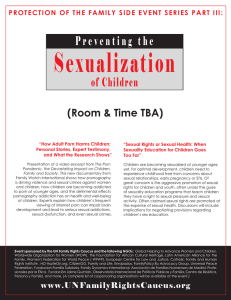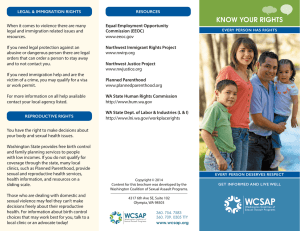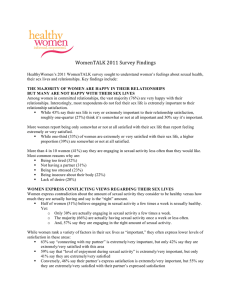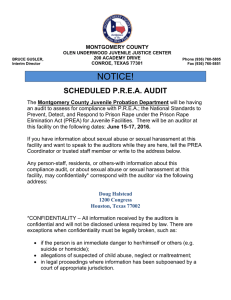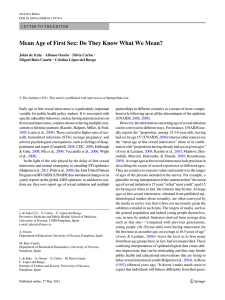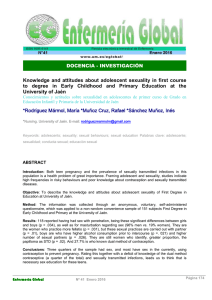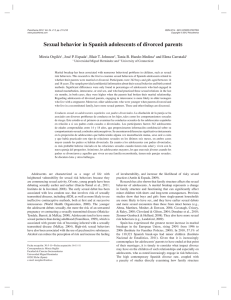Prevalence of Pattern of Risky Behaviors for Reproductive and
Anuncio
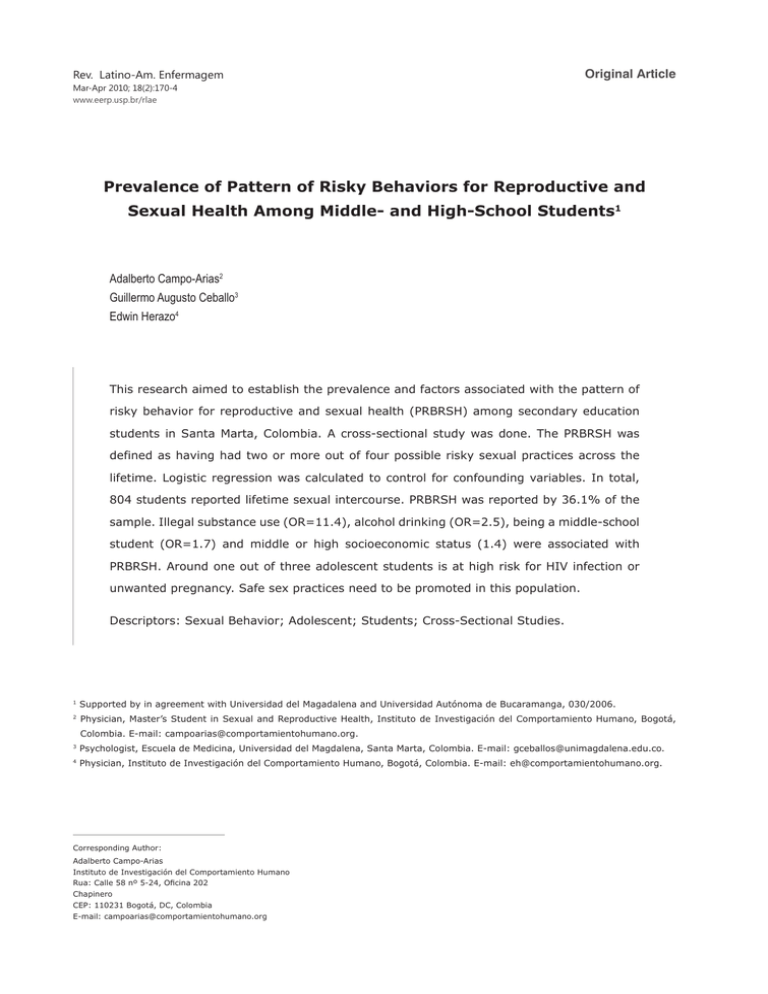
Rev. Latino-Am. Enfermagem Original Article Mar-Apr 2010; 18(2):170-4 www.eerp.usp.br/rlae Prevalence of Pattern of Risky Behaviors for Reproductive and Sexual Health Among Middle- and High-School Students1 Adalberto Campo-Arias2 Guillermo Augusto Ceballo3 Edwin Herazo4 This research aimed to establish the prevalence and factors associated with the pattern of risky behavior for reproductive and sexual health (PRBRSH) among secondary education students in Santa Marta, Colombia. A cross-sectional study was done. The PRBRSH was defined as having had two or more out of four possible risky sexual practices across the lifetime. Logistic regression was calculated to control for confounding variables. In total, 804 students reported lifetime sexual intercourse. PRBRSH was reported by 36.1% of the sample. Illegal substance use (OR=11.4), alcohol drinking (OR=2.5), being a middle-school student (OR=1.7) and middle or high socioeconomic status (1.4) were associated with PRBRSH. Around one out of three adolescent students is at high risk for HIV infection or unwanted pregnancy. Safe sex practices need to be promoted in this population. Descriptors: Sexual Behavior; Adolescent; Students; Cross-Sectional Studies. 1 Supported by in agreement with Universidad del Magadalena and Universidad Autónoma de Bucaramanga, 030/2006. 2 Physician, Master’s Student in Sexual and Reproductive Health, Instituto de Investigación del Comportamiento Humano, Bogotá, 3 Psychologist, Escuela de Medicina, Universidad del Magdalena, Santa Marta, Colombia. E-mail: gceballos@unimagdalena.edu.co. 4 Physician, Instituto de Investigación del Comportamiento Humano, Bogotá, Colombia. E-mail: eh@comportamientohumano.org. Colombia. E-mail: campoarias@comportamientohumano.org. Corresponding Author: Adalberto Campo-Arias Instituto de Investigación del Comportamiento Humano Rua: Calle 58 nº 5-24, Oficina 202 Chapinero CEP: 110231 Bogotá, DC, Colombia E-mail: campoarias@comportamientohumano.org 171 Prevalência do padrão de comportamento de risco para a saúde sexual e reprodutiva em estudantes adolescentes O objetivo desta pesquisa foi estimar a prevalência e alguns fatores associados ao padrão de comportamento de risco para a saúde sexual e reprodutiva (PCRSSR), em estudantes do segundo grau de Santa Marta, Colômbia. É um estudo transversal. O PCRSSR foi definido como a soma de dois ou mais, de quatro possíveis comportamentos sexuais de risco, durante a vida. Foi usada a regressão logística para controlar as variáveis de confusão. Do estudo participaram 804 estudantes, os quais relataram relações sexuais, 36,1% apresentaram padrão de comportamento de risco para a saúde sexual e reprodutiva. Foram relacionados ao PCRSSR o consumo de uma sustância ilegal (OR=11,4), o consumo de álcool (OR=2,5), ser estudante de educação de segundo grau vocacional (OR=1,7) e ter nível de renda média ou alta (1,4). Aproximadamente um de cada três estudantes adolescentes possuía alto risco de infecção para HIV, ou gravidez não planejada. Recomenda-se promover práticas sexuais seguras. Descritores: Comportamento Sexual; Adolescente; Estudantes; Estudos Transversais. Prevalencia de patrón de comportamiento de riesgo para la salud sexual y reproductiva en estudiantes adolescentes El objetivo de esta investigación fue establecer la prevalencia y factores asociados al patrón de comportamiento de riesgo para la salud sexual y reproductiva (PCRSSR) en estudiantes de secundaria de Santa Marta, Colombia. Se realizó un estudio transversal. Se definió como PCRSSR la suma de dos o más, de cuatro posibles, comportamientos sexuales de riesgo durante la vida. Se usó la regresión logística para controlar variables de confusión. Un grupo de 804 estudiantes informó haber tenido relaciones sexuales. El 36,1% mostró el estándar de comportamiento de riesgo para la salud sexual y reproductiva. Se relacionaron con el PCRSSR el consumo de una sustancia ilegal (OR=11,4), el consumo de alcohol (OR=2,5), el ser estudiante de educación media vocacional (OR=1,7) y el pertenecer al estrato socioeconómico medio o alto (1,4). Aproximadamente uno de cada tres estudiantes adolescentes presenta alto riesgo de ser infectado por el VIH o de sufrir un embarazo no planificado. Se recomienda promover prácticas sexuales seguras. Descriptores: Conducta Sexual; Adolescente; Estudiantes; Estudios Transversales. Introduction In Colombia, approximately 25% of secondary several sexual behaviors that represent risks for sexually education students inform previous sexual relations. transmitted infections or unplanned pregnancies are Also, these sexually active adolescents mention many more frequent in the same group of adolescents. Two unsafe sexual behaviors, including inconsistent condom decades ago, the concept of pattern of risky behaviors use, sexual intercourse under the effect of alcohol, for health was proposed, which means that different sexual relations after consuming illicit drugs and little or behaviors that can undermine sexual and physical recently known sexual partners . health are present in the same group of adolescents(5). (1) To date, research information on risky sexual behaviors has been isolated . However, the existence (2-4) of a pattern of risky behavior for reproductive and sexual health (PRBRSH) has been proposed. This means that www.eerp.usp.br/rlae Likewise, this group displays multiple risky behaviors, such as: cigarette consumption, antisocial behaviors and consumption of several possibly abuse substances(6). 172 Rev. Latino-Am. Enfermagem 2010 Mar-Apr; 18(2):170-4. The PRBRSH may be related with individual, you used a condom each time you have had sexual family, social and cultural variables that influence the intercourse?, Did you use a condom the last time you personality characteristics that are being consolidated(5). had a sexual relation?, Have you had sexual intercourse It is assumed that personality characteristics basically under the effect of alcohol?, Have you had sexual result from the interwoven search for novelty, search for intercourse under the effect of a drug like marihuana, pleasure and avoidance of pain . Despite the existence cocaine or another? and Have you had sexual intercourse of a National Sexual and Reproductive Health Policy and with a person you did not know well or had just met? a National Program for Sexuality and the Construction of The pattern of risky behaviors for reproductive and Citizenship in Colombia, which emphasize the education sexual health was arbitrarily defined as the sum of and training of young boys, girls and adolescents, until two or more risky sexual practices across the lifetime date, sexual behaviors that represent risks for HIV out of four possible options (inconsistent condom use, infection or unwanted pregnancies have not been studied sexual intercourse after alcohol consumption, sexual as a set or pattern of behaviors, nor have incidence intercourse after illegal drugs consumption or sexual levels and some variables been defined in international intercourse with a person you knew little or recently). or Colombian studies. After a pilot study and the adjustments needed, this (7) This research aimed to determine the prevalence instrument was used in another Colombian research(8). and some variables associated with the PRBRSH among This type of questionnaire has shown excellent reliability sexually active adolescents in Santa Marta, Colombia. in research around the world(9). Appropriate statistical measures were used for Method each type of variable (qualitative or quantitative), A cross-sectional study was designed. Written permission was requested from the participating school boards, the students’ parents and each student who agreed to participate. All participants received information about: the study purposes, their voluntary and anonymous participation, and the low physical and psychological risk associated. The Review Boards of a medical school in the city approved the research. Probabilistic cluster sampling was used in different phases, including all public and private, urban and rural, and middle and high schools in the Santa Marta District. with confidence intervals set at 95% (CI95%) when necessary. In bivariate analysis, odds ratios (OR) were determined with CI at 95%. Logistic regression was used for multivariate analysis, following common recommendations. In the final model, goodness of fit was estimated. Probabilities under 5% were accepted as significant differences. Data were analyzed using Statistical Package for the Social Sciences software (SPSS 13.0). Results In 2004, 43,261 students were enrolled, according to In total, 3,575 adolescents participated in this data by the District Education Secretary. The number research. A group of 804 (22.5%) informed previous of students in each conglomerate was estimated at sexual relations. Ages ranged between 14 and 20 years, 35 students. Based on previous research in the city, with mean for age of 14.8 years (SD=1.7) and 333 20% of students were expected to report a history of students (41.4%) younger than 15. Mean for education sexual relations, with a 5% alpha error and a 2% error was 8.9 years (SD=1.4), 510 students (63.4%) were margin. The replacement ratio was set at 20% in case taking high school education (grades ten or eleven); 629 of not wanting to participate or if data were missing in participants (78.2%) were men; 414 (51.5%) were in the forms. Finally, the sample was doubled to 3,690 public school; 456 (56.7%) belonged to middle or high participants for the sake of narrower confidence intervals socioeconomic status; 170 (21.1%) perceived their in multivariate analysis. health status as bad or regular during the last month; Participants answered a self-administered form 202 (25.1%) described their academic performance as in the classroom, comprising 30 questions about: bad or regular during the last month; 330 (41.0%) had demographic aspects, sexual behavior and other health- experimented cigarettes; 742 (92.3%) had consumed related aspects. Questions include: Have you ever had alcoholic beverages; and 64 (8.0%) had consumed sexual relations with another person?, How old were you some illegal drug, such as marihuana. when you had your first sexual relationship?, With how many people have you had sexual intercourse?, Have With regard to sexual behavior, 33.7% informed inconsistent condom use, 18.4% reported sexual www.eerp.usp.br/rlae 173 Campo-Arias A, Ceballo GA, Herazo E. intercourse after alcohol consumption, 5.8% after illegal following as a whole: sexual behavior, level of physical drugs consumption and 40.0% had sexual relations with activity, nutritional habits and consumption of legal a little known person. A group of 290 students (36.1%) and illegal drugs as a pattern of risky behavior for showed a pattern of risky behavior for sexual and health(11-12). reproductive health. Undoubtedly, Research needs to adopt an The following odds ratios (OR) were associated, integrated and holistic perspective towards behavior in bivariate analysis, with the PRBRSH: age under 15 during adolescence. The PCRSSR may be related to the years (OR=1.2; CI95% 0.9-1.6), male gender (OR=1,2; pattern of risky behavior for health, with a common CI95% 0.8-1.7), being a high school student (OR=1.3; biological CI95% 0.9-1.7), going to a public school (OR=0,9; The PCRSSR may be a necessary but insufficient CI95% 0.7-1.2), belonging to a middle or high social manifestation to observe the pattern of risky behavior class (OR=1.7; CI95% 1.3-2.3), perception of bad or for general health. The personality characteristics that regular health (OR=1.3; CI95% 0.9-1.9), perception are being consolidated during adolescence may very of academic performance (OR=1.0; CI95% 0.7-1.4), well explain these behavioral patterns(7). Adolescents having experimented cigarettes some time in life with antisocial, dependent or paranoid personality (OR=1.7; CI95% 1.3-2.3), having consumed alcoholic characteristics display more risky sexual behaviors beverage some time in life (OR=2.5; CI95% 1.3-4.8) for and experimenting some illegal drug (OR=10.2; CI95% pregnancies 5.2-19.9). or sexually social and transmitted (6,13) cultural infections predisposition(5). or unplanned . A collective approach towards adolescents’ sexual In the multivariate model, it was observed that a health is important from a public health perspective, as significant association continued to exist between the proposed by the National Sexual and Reproductive Health following variables and the PRBRSH: having consumed Policy and the National Program for Sexuality and the an illegal drug some time in life (OR=11.4; CI95% Construction of Citizenship by the Ministry of Education 5.7-22.7), having consumed alcohol some time in life of the Republic of Colombia, disseminated in 2008. This (OR=2.5; CI95% 1.3-5.1), being a mid secondary group of adolescents needs particular intervention or student (OR=1.7; CI95% 1.2-2.4); and belonging attention, including specific programs to stimulate safe to a middle or high socioeconomic status (OR=1.4; sexual practices that equally consider the personality CI95% 1.1-2.0). Goodness of fit of this model was characteristics that are being consolidated(5,7). Careful adequate (Hosmer-Lemeshow test X2=4.87; degrees of assessment of how these programs affect the sexual freedom=5; p=0.181). behavior of Colombian adolescents will undoubtedly be necessary. Discussion One important contribution of this research is that The pattern of risky behavior for sexual and reproductive health was observed in 36% of adolescents with a history of sexual relations. The pattern was more frequent among student who informed previous consumption of an illegal drug some time in life, previous consumption of alcohol some time in life, being a high school student (grades ten and eleven), and belonging to a middle or high socioeconomic class. No studies are available that inform on the PCRSSR it gives a composite picture of risky sexual behaviors in adolescents, as a pattern of risky behavior for sexual and reproductive health, which had not been investigated this way until date. The research shows the limits characteristic of a cross-sectional study though, which does not permit clarity on the sense of the association. Conclusion among adolescents in the global context. Until date, In conclusion, approximately one in every three most researchers have only informed on the variables adolescent students presents a pattern of risky sexual associated with sexual relations some time in life(2-4). and reproductive health behavior, that is, they are at high As several behaviors can jeopardize health, in general, risk of HIV infection or unwanted pregnancy. Safe sexual they appear in the same group of people practices need to be promoted and further research is (10) . Some recent studies among adolescents have looked at the www.eerp.usp.br/rlae needed on adolescent sexual behavior in general. 174 Rev. Latino-Am. Enfermagem 2010 Mar-Apr; 18(2):170-4. References 1. Campo-Arias A. Relaciones sexuales en adolescentes character inventory in a preadolescent twin sample. Behav colombianos y las implicaciones para la salud pública: una Genet 2009; 39:36-47. revisión de la prevalencia y algunas variables asociadas. 8. Castillo M, Meneses M, Silva JL, Navarrete PA, Campo A. Medunab 2009; 12:86-90. Prevalencia de relaciones sexuales en adolescentes estudiantes de 2. Atav S, Spencer GA. Health risk behaviors among adolescents un colegio de Bucaramanga, Colombia. Medunab 2003; 6:137-43. attending rural, suburban, and urban schools: a comparative 9. Brener N, Billy JOG, Grady WR. Assessment of factors study. Fam Community Health 2002; 25:53-64. affecting the validity of self-reported health risk behavior among 3. Vinaccia S, Quiceno JM, Gaviria AM, Soto AM, Gil MD, Ballester adolescents: evidence from the scientific literature. J Adolesc R. Conductas sexuales de riesgo para la infección por VIH/sida Health 2003; 33:436-57. en adolescentes colombianos. Terap Psicol 2007; 25:39-50. 10. Burke V, Milligan RAK, Beilin LJ, Dunba D, Spencer M, Balde 4. Tuesta R, Navarro E, Medina A, Molina I, Náder N, Numa L. E, et al. Clustering of health-related behaviors among 18-year- Hábitos de salud de los escolares de una institución pública old Australians. Prev Med 1997; 26:724-33. en el municipio de Soledad (Atlántico). Salud Uninorte 2007; 11. Takakura M, Nagayama T, Sakihara S, Willcox C. Patterns 23:135-49. of health-risk behavior among Japanese high school students. J 5. Rew L, Horner SD. Youth resilience framework for reducing Sch Health 2001; 71:23-9. health-risk behaviors in adolescents. J Pediatr Nurs 2003; 12. Campo-Arias A, Cogollo Z, Díaz CE. Comportamientos 18:379-88. relacionados 6. Mun EY, Windle M, Schainker LS. A model-based cluster prevalencia y factores asociados. Salud Uninorte 2008; 24: analysis approach to adolescent problem behaviors and young 226-34. adult outcomes. Dev Psychopathol 2008; 20:291-318. 13. Lavan H, Johnson JG. The association between Axis I and 7. Isen JD, Baker LA, Raine A, Bezdjian S. Genetic and II psychiatric symptoms and high-risk sexual behavior during environmental influences on the junior temperament and adolescence. J Pers Disord 2002; 16:73-94. con la salud en adolescentes estudiantes: Received: Mar. 31st 2009 Accepted: Dec. 1st 2009 www.eerp.usp.br/rlae
